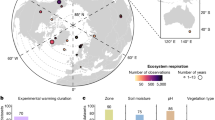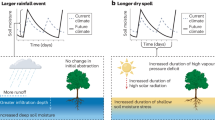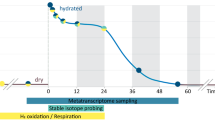Abstract
Global warming is predicted to induce desiccation in many world regions through increases in evaporative demand1,2,3. Rising CO2 may counter that trend by improving plant water-use efficiency4,5. However, it is not clear how important this CO2-enhanced water use efficiency might be in offsetting warming-induced desiccation because higher CO2 also leads to higher plant biomass, and therefore greater transpirational surface2,6,7. Furthermore, although warming is predicted to favour warm-season, C4 grasses, rising CO2 should favour C3, or cool-season plants8. Here we show in a semi-arid grassland that elevated CO2 can completely reverse the desiccating effects of moderate warming. Although enrichment of air to 600 p.p.m.v. CO2 increased soil water content (SWC), 1.5/3.0 °C day/night warming resulted in desiccation, such that combined CO2 enrichment and warming had no effect on SWC relative to control plots. As predicted, elevated CO2 favoured C3 grasses and enhanced stand productivity, whereas warming favoured C4 grasses. Combined warming and CO2 enrichment stimulated above-ground growth of C4 grasses in 2 of 3 years when soil moisture most limited plant productivity. The results indicate that in a warmer, CO2-enriched world, both SWC and productivity in semi-arid grasslands may be higher than previously expected.
This is a preview of subscription content, access via your institution
Access options
Subscribe to this journal
Receive 51 print issues and online access
$199.00 per year
only $3.90 per issue
Buy this article
- Purchase on Springer Link
- Instant access to full article PDF
Prices may be subject to local taxes which are calculated during checkout




Similar content being viewed by others
References
Wang, G. Agricultural drought in a future climate: results from 15 global change models participating in the IPCC 4th assessment. Clim. Dyn. 25, 739–753 (2005)
Seager, R. & Vecchi, G. A. Greenhouse warming and the 21st century hydroclimate of southwestern North America. Proc. Natl Acad. Sci. USA 107, 21277–21282 (2010)
Woodhouse, C. A., Meko, D. M., MacDonald, G. M., Stahle, D. W. & Cook, E. R. A 1,200-year perspective of 21st century drought in southwestern North America. Proc. Natl Acad. Sci. USA 107, 21283–21288 (2010)
Morgan, J. A. et al. Water relations in grassland and desert ecosystems exposed to elevated atmospheric CO2 . Oecologia 140, 11–25 (2004)
Leakey, A. D. B. Rising atmospheric carbon dioxide concentration and the future of C4 crops for food and fuel. Proc. R. Soc. Lond. B 276, 2333–2343 (2009)
Frelich, L. E. & Reich, P. B. Will environmental changes reinforce the impact of global warming on the prairie–forest border of central North America? Front. Ecol. Environ 8, 371–378 (2010)
Piao, S. et al. Changes in climate and land use have a larger direct impact than rising CO2 on global river runoff trends. Proc. Natl Acad. Sci. USA 104, 15242–15247 (2007)
Ehleringer, J. R., Cerling, T. E. & Helliker, B. R. C-4 photosynthesis, atmospheric CO2 and climate. Oecologia 112, 285–299 (1997)
Asner, G. P., Elmore, A. J., Olander, L. P., Martin, R. E. & Harris, A. T. Grazing systems, ecosystem responses, and global change. Annu. Rev. Environ. Resour. 29, 261–299 (2004)
Suttie, J. M., Reynolds, S. G. & Batello, C. Grasslands of the World (FAO, 2005)
Noy-Meir, I. Desert ecosystems: environment and producers. Annu. Rev. Ecol. Syst. 4, 25–51 (1973)
McNaughton, K. G. & Jarvis, P. G. Effects of spatial scale on stomatal control of transpiration. Agric. For. Meteorol. 54, 279–301 (1991)
Epstein, H. E. et al. The relative abundance of three plant functional types in temperate grasslands and shrublands of North and South America: effects of projected climate change. J. Biogeogr. 29, 875–888 (2002)
Polley, H. W. Implications of rising atmospheric carbon dioxide concentration for rangelands. J. Range Mgmt 50, 562–577 (1997)
Semmartin, M., Aguiar, M. R., Distel, R. A., Moretto, A. S. & Ghersa, C. M. Litter quality and nutrient cycling affected by grazing-induced species replacements along a precipitation gradient. Oikos 107, 148–160 (2004)
Tieszen, L. L., Reed, B. C., Bliss, N. B., Wylie, B. K. & DeJong, D. D. NDVI, C3 and C4 production, and distributions in Great Plains grassland land cover classes. Ecol. Appl. 7, 59–78 (1997)
Miglietta, F. et al. Free-air CO2 enrichment (FACE) of a poplar plantation: the POPFACE fumigation system. New Phytol. 150, 465–476 (2001)
Kimball, B. A. et al. Infrared heater arrays for warming ecosystem field plots. Glob. Change Biol. 14, 309–320 (2008)
Derner, J. D. & Hart, R. H. Grazing-induced modifications to peak standing crop in northern mixed-grass prairie. Rangeland Ecol. Mgmt 60, 270–276 (2007)
Hovenden M. J. et al. Influence of warming on soil water potential controls seedling mortality in perennial but not annual species in a temperate grassland. New Phytol. 180, 143–152 (2008)
Morgan, J. A., Milchunas, D. G., LeCain, D. R., West, M. & Mosier, A. R. Carbon dioxide enrichment alters plant community structure and accelerates shrub growth in the shortgrass steppe. Proc. Natl Acad. Sci. USA 104, 14724–14729 (2007)
Milchunas, D. G., Morgan, J. A., Mosier, A. R. & LeCain, D. R. Root dynamics and demography in shortgrass steppe under elevated CO2, and comments on minirhizotron methodology. Glob. Change Biol. 11, 1837–1855 (2005)
Luo, Y., Sherry, R., Zhou, X. & Wan, S. Terrestrial carbon-cycle feedback to climate warming: experimental evidence on plant regulation and impacts of biofuel feedstock harvest. Glob. Change Biol. Bioenergy 1, 62–74 (2009)
Dijkstra, F. A. et al. Contrasting effects of elevated CO2 and warming on nitrogen cycling in a semiarid grassland. New Phytol. 187, 426–437 (2010)
LeCain, D. R., Morgan, J. A., Mosier, A. R. & Nelson, J. A. Soil and plant water relations determine photosynthetic responses of C3 and C4 grasses in a semi-arid ecosystem under elevated CO2 . Ann. Bot. (Lond.) 92, 41–52 (2003)
Wand, S. J. E., Midgley, G. F., Jones, M. H. & Curtis, P. S. Responses of wild C4 and C3 grass (Poaceae) species to elevated atmospheric CO2 concentrations: a meta-analytic test of current therories and perceptions. Glob. Change Biol. 5, 723–741 (1999)
Meehl, G. A. et al. in Climate Change 2007: The Physical Science Basis. Contribution of Working Group I to the Fourth Assessment Report of the IPCC (eds Solomon, S. et al.) 747–845 (Cambridge Univ. Press, 2007)
Kimball, B. A. in Irrigation of Agricultural Crops (Agronomy Monograph No. 30) 2nd edn (eds Lascano, R. J. & Sojka, R.E. ) 627–653 (American Society of Agronomy, Crop Science Society of America and Soil Science Society of America, 2007)
Acknowledgements
We thank D. Smith for installation and operation of the PHACE experiment, E. Hardy for assistance in installation, A. Eden and C. Brooks for data collection and analysis, F. Miglietta for advice and help on installation of the FACE system, and R. Seager, A. Leakey, B. Cook and G. Wang for comments on the manuscript. The work was supported by the US Department of Agriculture-Agricultural Research Service Climate Change, Soils & Emissions Program, the US Department of Agriculture-Cooperative State Research, Education, and Extension Service Soil Processes Program (grant no. 2008-35107-18655), the US Department of Energy’s Office of Science (Biological and Environmental Research) through the Western Regional Center of the National Institute for Climatic Change Research at Northern Arizona University, and the National Science Foundation (DEB no. 1021559). Mention of commercial products is solely for the purpose of providing specific information and does not imply recommendation or endorsement by the USDA.
Author information
Authors and Affiliations
Contributions
J.A.M., E.P., D.M.B., B.A.K., D.G.W. and M.W. conceived the study. J.A.M., D.R.L., E.P., D.M.B., Y.C., D.G.W., J.H.-W. and F.A.D. performed the experiment. B.A.K. designed the warming system and conducted the evapotranspiration analysis. J.A.M. wrote the paper and the remaining authors contributed to the writing. Statistical analyses using SAS/STAT software, version 9.2, Proc GLIMMIX were performed by M.W. and J.A.M. The regression analyses using JMP software were performed by D.M.B. and J.A.M. Figures were developed by D.R.L.
Corresponding author
Ethics declarations
Competing interests
The authors declare no competing financial interests.
Supplementary information
Supplementary Information
This file comprises 3 appendices: I Experimental Methods and System Performance; II Soil Water Content and III Global Change Treatments and Plant Responses. The file also contains Supplementary Figures 1-5 with legends, Supplementary Tables 1-2 and additional references. (PDF 613 kb)
Rights and permissions
About this article
Cite this article
Morgan, J., LeCain, D., Pendall, E. et al. C4 grasses prosper as carbon dioxide eliminates desiccation in warmed semi-arid grassland. Nature 476, 202–205 (2011). https://doi.org/10.1038/nature10274
Received:
Accepted:
Published:
Issue Date:
DOI: https://doi.org/10.1038/nature10274
This article is cited by
-
Mapping the global distribution of C4 vegetation using observations and optimality theory
Nature Communications (2024)
-
Experimental Evidence Supporting the Seasonal Availability of Water Hypothesis in a Mixed C3/C4 Grassland
Ecosystems (2024)
-
Plant economic strategies in two contrasting forests
BMC Plant Biology (2023)
-
Wetting and drying trends under climate change
Nature Water (2023)
-
Climate Change Effects on Phosphorus Loss from Agricultural Land to Water: A Review
Current Pollution Reports (2023)
Comments
By submitting a comment you agree to abide by our Terms and Community Guidelines. If you find something abusive or that does not comply with our terms or guidelines please flag it as inappropriate.



